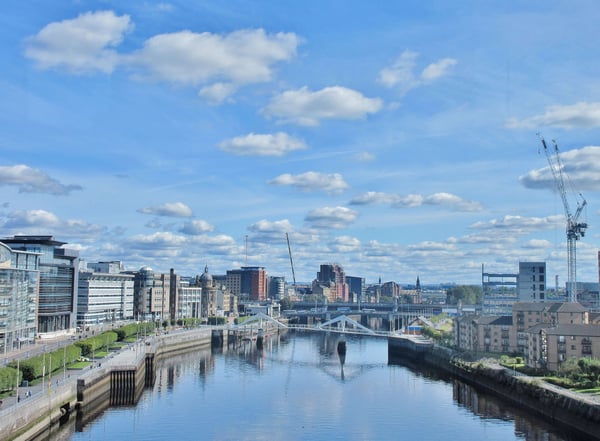To say Glasgow’s reputation is chequered would be an understatement. To some it is Edinburgh’s friendlier neighbour, where people speak their mind, and authentic Scottish culture resides. To others, it’s knock-off goods sold at the Barras Market, knife crime, and economic deprivation. If the former stereotype has resonance, the latter is a pastiche of times long since passed. As everywhere, Glasgow still has problems, but it is mistaken to think it conforms to a grizzly episode of Taggart. Its Merchant City and West End offer restaurants worthy of Michelin acclaim, and it is within a short drive of Loch Lomond and the Trossachs, surely one of the most stunning green spaces anywhere in the UK. Prior to Covid, Glasgow Airport afforded access to the Middle East and North America, as well as a smorgasbord of European capitals. These attributes have not gone unnoticed to corporates and multinationals, who have seen merit in focusing operations in Glasgow.

The economic base of the city has undergone significant change in the last few decades. Once widely associated with shipbuilding, its earlier affluence also owed to the tobacco and the locomotive construction industries. As in much of the rest of the UK- and indeed the Western world- there has been a reduction in manufacturing activity, driven, in part, by the ascendance of East Asian countries. The adjustment has been particularly pronounced in Glasgow, where manufacturing now accounts for only 5% of the industrial base. This places the city 52nd amongst the 62 principal urban areas of the UK. This change has emotional as well as economic consequences, and has fed the perception of post industrial malaise. However, dig a little further, and Glasgow has successfully repositioned in a way many UK, and indeed American cities, have not.
There has been an increase in the portion of the working population engaged in tertiary industries. These include healthcare, business and financial services, tourism, retail and higher education. Indeed given it is the fourth largest urban area in the UK, it is striking, nearly 14% of the industrial structure is in private knowledge intensive business services, placing it 21st in the UK. In other private services, it ranks thirteenth with an impressive 46% of its base. In no way to denigrate the vital role played by the public sector, Glasgow defies the assumption of over dependence on output deriving from government. Only 28% of the Glaswegian economy can be attributed to public services, demonstrating balance relative to many of the UK’s urban areas. Glasgow has been quick to adjust to new realities, embracing a high concentration of call centres, surpassing all other parts of the UK, and bucking global outsourcing trends.
Notable companies in Glasgow include the FTSE 250 Aggreko, supplying temporary power generation equipment to countries all over the world. Other familiar names include BAE Systems Maritime, Britoil, Clydesdale Bank, Drambuie and SgurrEnergy. The introduction of new names supplementing traditional industries, have contributed to high average weekly workplace earnings at £520, meaning Glaswegians earn more than many of their fellow city dwellers across the UK. This has not come at the expense of job creation, with private sector jobs increasing 7% between 2015 and 2018, and population only increasing 3% during the same period. This trend is manifest in the impressive 11% increase in Glasgow’s GDP in three years, in spite of continued uncertainty both as to Brexit and Scottish Independence.
Analysis from Savills regarding the commercial property market accords with these broader macro trends. In its most recent report in Spring 2020, Glasgow’s office market saw strong momentum in the first quarter, with city centre take-up, growing 94% relative to the same period of the preceding year. This built upon a strong performance in recent times where large financial services firms such as Barclays and JP Morgan have committed to sites in the city.In the case of the latter, the selection of the Glasgow Technology Centre, located within the International Financial District was significant. It was one of only two strategic European technology hubs selected by the bank, and a vote of confidence in Glasgow’s potential. This said, Glasgow has become a victim of its own success with only 6,500 square feet of prime, new, A-class space left available. This is likely to place upward pressure on prime rents which stand at £34 currently. It is also supportive of the investment market where Savills report £150m of office space in Glasgow under offer. The broader repercussions of the coronavirus shutdown notwithstanding, recent experience indicates a tightening of yields in Glasgow.
If A-class provision has catered to multinationals and corporates, Glasgow has enduring popularity for headquartering major public sector entities. Typically taking space in B-class buildings, these tenants have historically been of interest to pension and life funds since they offer quasi-sovereign debt at higher rates of return than government bonds. Savills point to data which suggests 60% of total transactions in the first quarter of 2020 were in this space. The Scottish Government took 90,500 sq.ft. of B-class space at 220 High Street, while Skills Development Scotland took 27,00 sq.ft. at Monteith House. The enduring appeal of Glasgow as a location for both public and private sector organizations, positions the city well to weather some of the pandemic-induced challenges which surely lie ahead.

At Propeterra, we seek to provide investors with access to deal flow at all levels of the market through timely identification of sectors which are structurally under-priced. As is the case in our analysis of the office sector in Leeds, Glasgow is beginning to emerge as one of the necessary economic centres if the UK is to move away from overdependence on London. This was clearly front of mind when Glasgow was granted a City Deal fund worth £1.1bn with the scope to attract a further £3bn in matching funds from the private sector. It is likely this also informed the decision to upgrade the Glasgow-Edinburgh rail link reducing journey times to 42 minutes and joining 3.3 million people- one of the top twenty largest regions in Europe. In any office market globally- and particularly in one following a public health crisis- access to human capital is vital. Propeterra anticipates Glasgow will continue to build on its success given 70% of the population is working age, and 44% of Glaswegians are educated to degree level or above, six percentage points ahead of the UK average. Combine this with the fact it is one of Europe’s fastest growing urban areas and the second most productive in the UK, it’s not difficult to conclude the so-called River City is one to watch.







